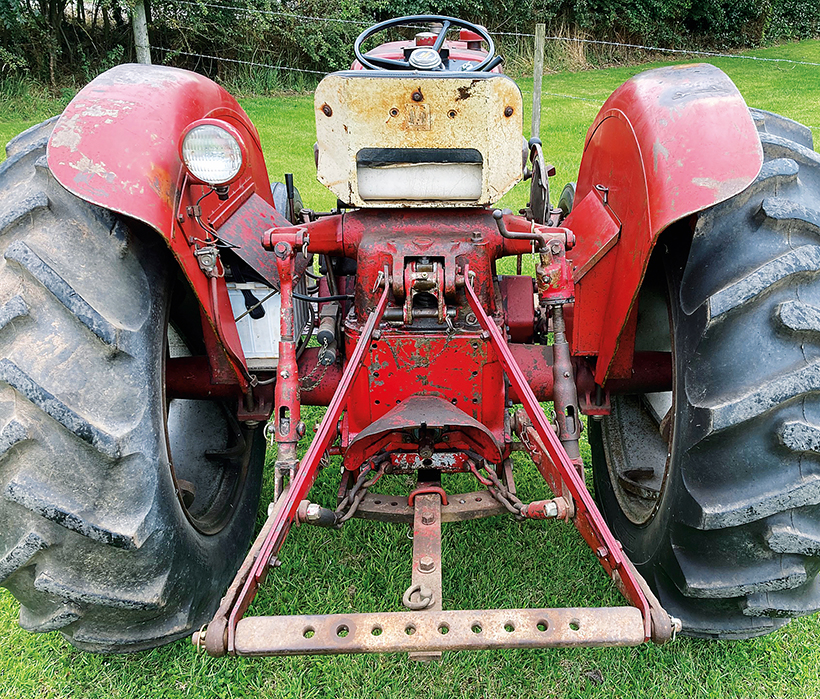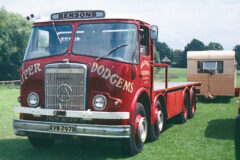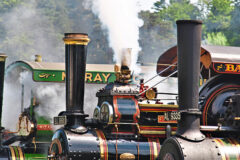International Harvester 424; a fantastic utility tractor!
Posted by Chris Graham on 6th September 2023
Scott Lambert examines the International Harvester 424 that resulted from collaboration between the company’s American and British arms.

International Harvester 424: An American tractor in the English countryside. Or is it? (All photos: David Musson)
Following the success of the B-414, built from 1961-66, the International Harvester Company of Great Britain introduced the 434 – a 43hp, four-cylinder tractor capable of pulling a four-furrow plough in appropriate conditions – but the underpinnings were virtually identical and demonstrated the reliability of the skid unit assembled at IH’s Idle facility in West Yorkshire.
With more than 29,000 diesel-powered B-414s built there and sold across Europe by the end of 1963, as well as almost 3,500 petrol examples, the model had proved itself to be a useful and adaptable tractor – a solid reason for choosing it as the basis for a ‘Utility’ model to suit the North American market, as well as the underpinnings of the new 434, from ’66.
Tractors like the American-built 300 and 330 were similar to the B-250 and B-275 in terms of size and power output and were well liked by American farmers, but there was evidently a place for the British-built skid unit, as it would be shipped from England to Louisville, Kentucky, to be turned out as the 424 from 1964.
Diesel was the fuel of choice across Europe, but in North America gasoline engines still made up a significant portion of the tractor market – both in four- and six-cylinder forms. Large tractors formed the backbone of farming operations across The Pond, due to the huge acreages that were farmed, but there was still a place for ‘Utility’ tractors, and it was concluded that the Bradford-built skid unit would suit such a role well.

From left to right: IH 424, B-414 and 434. Three different styles based on the same skid unit.
The BD-154 diesel engine would be part of the package sent to North America from Great Britain, but the Louisville-built C-146 petrol unit was also married to the transmission once it arrived, for those that preferred spark ignition.
The British elements of the new 424 included the diesel engine (where fitted), transmission, brakes, hydraulic system, and drawbar assembly. The bonnet was fitted in the USA, along with the front axle, wheels, radiator, mudguards, and elements of the electrical system.
A first glance suggests it’s pure Americana, but look closer and it’s very much a ‘hybrid’ of the B-414 skid unit and US-built sub-assemblies.
In terms of the diesel engine, the BD-154 needs little explanation, other than that it generated 36½hp at the PTO shaft. It was a unit renowned for its torque characteristics, as well as needing plenty of heat to get it going, whereas the C-146 won’t be familiar to the bulk of readers.

It’s obviously a Bradford-built skid unit, but the instrument panel is very different to tractors built for the British and European markets.
Performance pointers
Key features included a 33⁄8in sleeveless bore and 41⁄16in stroke, with the aluminium alloy pistons containing two compression rings and one oil ring. The crankshaft was induction hardened, with three main bearings, while the rated speed was the same as the diesel at 2,000rpm. A Marvel-Schebler TSX-896 carburettor was fitted to the 424, but different carburettors were used for other C-146-powered models.
Nebraska tests revealed PTO performance of 36.97hp at rated engine speed for the petrol tractor and 36.91hp for the diesel, with fuel use of three gallons and 2.6 gallons per hour respectively. Drawbar performance was 31.44hp and 31.9hp respectively, with maximum pull (in first gear) of 5,282lb (2,395kg) for the petrol model and 5,374lb (2,437kg) for the diesel.
At the rear of the engine, two types of clutch were used – dependent on the transmission fitted. The standard system utilised an 11in-diameter engine clutch and nine-inch PTO clutch, when the eight-forward, two-reverse transmission was fitted, but an eight-forward, eight-reverse ‘Forward-reverse drive’ gearbox was an option, utilising an 11in-diameter single clutch.
Underneath the radiator was one of the most striking parts of the 424 – the front axle. A ‘swept back’ unit made of tubular steel, like that fitted to early IH 454s built in Doncaster, it featured integral stay rod bracing (with the rear connection point beneath the bell housing) and telescopic adjustment to permit differing track widths.

This tractor has one double-acting spool valve fitted, operated by the lever under the seat.
A worm and gear manual steering system was a standard fitment, but many purchasers opted for the optional hydrostatic power steering set-up that required less than three-and-a-half turns of the steering wheel from lock to lock.
The braking system was the double dry disc arrangement that owners of Bradford-built tractors will be familiar with, comprising externally mounted 6½in-diameter discs actuated mechanically on the differential shafts. A lever-operated parking brake was also included.
At the rear, unlike many American-built models, a three-point linkage was standard – with the Vary-Touch two-lever quadrant that was introduced with the B-414. The hydraulic system, including the oil needed to operate it, was housed in the top cover above the rear axle and was limited to 2,250psi, although the relief valve for the auxiliary valve circuit blew at 1,500psi and 1,600psi for the power steering.
Like the B-414, the hydraulic system was driven by an engine-mounted pump with flow and return pipes running along the right-hand side of the engine. Single- or double-acting spool valves could be fitted at various points around the tractor, but it was common to see one double-acting bank at the rear.

The obvious difference between the B-414 and 424 from the rear is the mudguards. They’re similar in shape but house the battery and a toolbox.
The power take-off was a six-spline, 540rpm unit, with guard.
Standard wheels and tyres were 5.50-16 fronts and 12.4-28 rears on pressed steel rims, but power-adjusted rear wheels could be specified as an option. Alternative tyre sizes were 6.00-16 and 7.50-16 fronts, with 13.6-28s at the rear.
High spec
It must be said that the operator’s area was certainly nicer than that of the B-414 and arguably better than the 434 too. With the bonnet tapering to the instrument panel, getting on and off was much easier than the B-414 and the rake of the dash made it easy to see the instrumentation – which comprised speedometer/tachometer, ‘pepper pot’ glow plug indicator (diesel only), temperature indicator light, charge indicator light, oil pressure warning light, and there was even a cigarette lighter!
The deluxe seat, like that used on the 434, was comfortable and adjustable to suit the driver’s height, as well as hinged to keep the rain off it when not in use.
Basic specification was comprehensive, but other optional equipment included a fuel gauge, foot throttle, and vertical silencer. There’s little doubt that there was every opportunity to create a ‘fully loaded’ 424 when determining the spec of a tractor at the local dealership. It may have been small, but the 424 had a great deal going for it.

A close up of the swept-back, tubular steel front axle with integral stay rod bracing. This tractor features optional power steering.
This example was imported from Colorado in 2010 by David Musson, from Derbyshire, having been used to fill grain bins with a PTO-driven auger. David used IH equipment on his farm throughout his working life and has visited the United States many times – including trips to the International Harvester Collectors Club’s Red Power Roundup.
He has a nice collection of IH tractors that includes a Rock Island-built 656, but the originality and specification of the 424, as well as the British connection, appealed to him and he made the decision to buy it and ship it to the UK.
“It’s a lovely little tractor,” he told Tractor & Machinery. “It has very light power steering and drives beautifully. The tractor turns on a sixpence, having the swept back axle, and I brought it over because it’s the same as the B-414 and 434, but different, if that makes sense!”
The 424 was only in production until 1967, by which time the 434 was also on sale in North America. It retained the styling of the 434 sold in Britain, save for the headlights positioned at the top of the grille, and although competent it did not have the style of the 424.

David Musson’s International Harvester 424 is fitted with the optional 6.00-16 front tyres and 13.6-28 rears, as well as power-adjusted rear wheels. Note the protrusions from the top of the bonnet – radiator cap, rocker cover breather, air intake and fuel filler cap.
The latter’s tapered bonnet line, swept back axle, and downswept exhaust created a silhouette that made it look very different from the other models produced for the British market using a Bradford-built skid unit, and that’s what makes the 424 so appealing. Like the hybrids that have flooded the motoring world, it will divide opinion, but it’s interesting to compare against others and is certainly different.
* Thanks to David Musson for his help in producing this article.
This feature comes from the latest issue of Tractor & Machinery, and you can get a money-saving subscritpion to this magazine simply by clicking HERE

Previous Post
Famous fairground families and their classic vehicles

Next Post
The brilliant Bon Accord Steam & Vintage Fair



